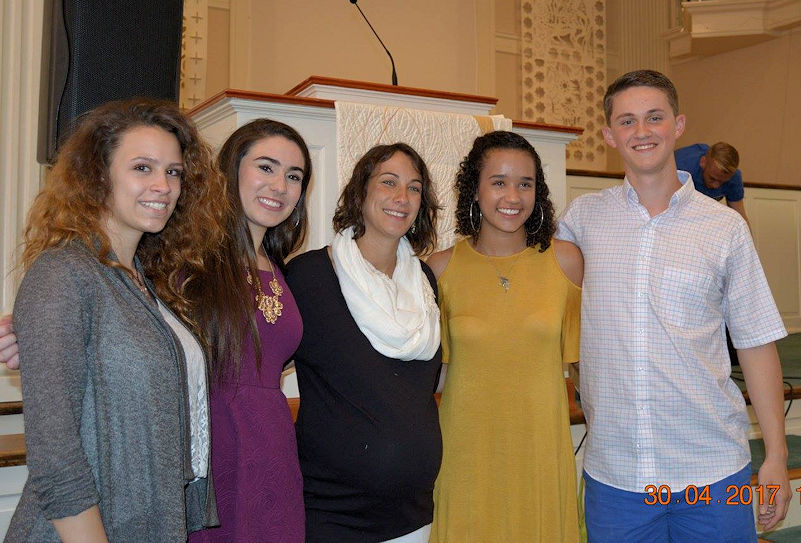A Man Went Down to Jericho
by Michael Usey
Luke 10.25-37
Have you ever noticed how many jokes and stories have three parts? “A rabbi, a priest and a Baptist preacher get to heaven….” A doctor, lawyer and preacher were walking down the road. The Three Little Pigs; The Three Bears; etc. The punch line usually comes with the third character in the story. Jesus told a parable in a familiar story form of his day, but threw in a huge surprise at the end. Of course, we know the surprise because we’ve heard it so often. And its familiar title, “The Parable of the Good Samaritan,” gives it away from the beginning.
The early church was wiser. They called parables by their first line. So, instead of “The Parable of the Prodigal Son,” they called it “A Certain Man Had Two Sons”—which is truer to the story as a whole. And today’s travel story was named, “A Man Went Down to Jericho.” It preserves the surprise at the end.
This parable has become universal in meaning. I met a Filipino who did not know the parable, but he knew what a “good Samaritan” was. How many hospitals and helping agencies through the centuries have been named “Good Samaritan Hospital.” The Church of the Savior in Washington D.C. has a ministry called “Samaritan House” that provides a safe place for people to get well when they are released from the hospital but have no viable place to go.
And, no passage so easily evokes three questions as we journey together through summer: Who am I in this story? What is God calling me to be and to do? And, who is my neighbor, the one God is calling me to love as myself?
“A lawyer stood up to test Jesus ….” At the time Jesus lived there were hundreds of laws governing most every aspect of life. The question posed to Jesus by the lawyer was one many have wondered about: “What must I do to win the prize of eternal life?” Typical of Jesus, he turns the question back on the lawyer. “What is written in the law?” The lawyer knew in theory the foundation of all laws could be traced to the Ten Commandments. In response the lawyer recited the summary of the Law. “You shall love the Lord your God with all your heart, and with all your soul, and with all your strength, and with all your mind; and your neighbor as yourself.” The lawyer was in the position of most of us; he could recite what the law said. He decided to take his question one step further: “And who is my neighbor?“
“Who is my neighbor?” This is a central question in the church today and one that is openly discussed in our nation. It is a question that surrounds the talk about immigration laws. It is a question related to how we treat each other from the corporate executive to the person not-yet-housed. “Who is my neighbor?” raises questions about race and sexual preference; it centers on party affiliation and how we respond to those who choose to have a differing opinion. “Who is my neighbor?” touches every aspect of our lives.
Jesus did not lecture the lawyer about neighborliness, instead he told him a story. It is a story that answered the lawyer’s initial question, “What must I do to inherit eternal life?” The story Jesus told is about putting words into action. While the lawyer wondered about attaining the reward, Jesus talked about eternal life now. In essence, Jesus told the lawyer eternal life is in the doing.
Jesus describes the mugged traveler as only “half-dead”—or as plague victims sing in Spamalot, “I’m not dead yet.” But people with serious work to do must take precautions. So the priest and Levite pass by, and as we 21st-century readers watch them go, we experience a satisfying sense of superiority—we recognize who our neighbor is. We feel justified by our reading of Jesus’ parable and confident that we could do better than the priest and the Levite.
Some years ago a famous experiment was conducted with seminary students. Researchers gathered a group of ministry students in a classroom and told them that each of them had an assignment. Their assignment was to record a talk about the parable of A Man Went Down to Jericho. The thing was, the recordings were going to be done in a building on the other side of the campus, and because of a tight schedule, they needed to hurry to that building. Unbeknownst to the students, on the path to the other building the researchers had planted an actor to play the part of a man in distress, slumped in an alley, coughing and suffering. The students were going to make a presentation about the Good Samaritan. But what would happen, the researchers wondered, when they actually encountered a man in need? Would they be good Samaritans? Well, no, as a matter of fact, they were not. Almost all of them rushed past the hurting man. One student even stepped over the man’s body as he hurried to teach about the Parable of A Man Went Down to Jericho.
We should not look down at these seminary students who couldn’t put this parable into practice, because neither can we. Simply knowing in our minds what the right thing to do is does not mean we can do it. If we are going to be good Samaritans, then this will mean more than a change of mind.
There are at least two challenges for post-modern readers of this story recorded by Luke. First and foremost, for the hearers of this parable in Jesus day, no Samaritans were considered to be good Samaritans. Samaritans were viewed with suspicion as outsiders. For us, every Samaritan is a “good” Samaritan, so we expect the compassionate response to the man beaten and lying beside the road.
The prevailing narrative in Jesus’ time was that a neighbor was someone who was a member of the covenant community and who shared a reciprocal relationship to support and promote welfare. A Samaritan did not fit this bill. In fact, Samaritans were considered “ethnically and religiously suspect.” While Samaritans saw themselves as true Israelites, Jews saw them as a result of a mixture of Assyrians and Israelites, especially a religious mixture. The lawyer would not have expected a Samaritan to be the protagonist of a story.
So Jesus rocks his world by telling a counter-story that challenges the lawyer’s ethno-religious bias and asks him to think and act differently.
Mikhail Bakhtin suggests that often outsiders in a story may have a fuller perception of what’s happening than insiders because their “outsidedness” puts them in a better position to see what’s really going on. Throughout the story of Jesus, outsiders often understand Jesus better, including the Samaritan woman at the well.
In this parable, we again see an outsider who better understands the law than the lawyer. So the story puts the lawyer — and Jesus’ listeners (and post modern readers) — on the spot. It disrupts our worldview of who our neighbor is, and it demands we act, not like the priest and Levite insiders, but like the Samaritan outsider.
At the core of this story is ethno-religious identity. We see a similar dynamic in white evangelical Christianity in America. What purports to be a religious identity is really a racial identity that shapes religion, which is why we often see behaviors so at odds with the teachings of Jesus.
As in the story of the A Man Went Down To Jericho, the insiders are those who by their embrace of ethnic and religious identity purport to know and keep the law, and yet we see that in centering these dominant identities they actually violate the spirit of the law they profess to keep. As the story shows us, it’s one thing to know the law and another to do it. It’s one thing to know Jesus and another to follow him. Or to paraphrase Bebe Moore Campbell, “Your Christianity ain’t like mine.”
Let’s be clear: Christianity without loving your neighbor, without standing for those who are oppressed, without a desire for more peaceful, kind, and just society isn’t Christianity at all. We cannot hide our violence and our intolerance behind our faith. Instead, we can normalize Christians being known what we are for, acting with unconditional love to our neighbors. We are for equal rights. We are for ending the death penalty. We are for full inclusion of all. We are for the Black community and racial justice. We are For the LGBTQI community.
Secondly, we see the situation too narrowly as one single man’s compassion. All we see are the victim, the perpetrator and the rescuer as the players in the story. We forget the bystanders who are just ordinary folk going about their business. My social worker sons have taught me to ask questions like, well, why was the road to Jericho so unsafe? Who or what was tasked with protecting travellers on this road?
There is a folktale from Burma that captures for me the essence of what Jesus was saying when he told the parable. It can perhaps remind us that there are no innocent bystanders.
Long ago a traveler was walking through the jungles of Burma when he came upon a small village. As the sun was going down, he decided to just sleep along the roadside and enter the village in the morning. Taking his coin purse from around his neck, he found a stone nearby and hid his purse so no one would take it as he slept. As it turned out, a villager had spotted him hiding the purse. Late at night as the traveler slept, the villager returned and stole the purse. When the traveler awoke, the money was gone. The traveler sat down beside the road and began to weep. A crowd began to gather curious about this traveler weeping on the edge of the village. Before long the mayor joined the crowd and inquired about the situation. He listened to the traveler and then asked to see the stone. The traveler walked a short distance to a round stone about the size of a man’s head.
The mayor ordered, “Arrest that stone. Bring that thief to the town square where I’ll convene a court.” The villagers followed the mayor and the traveler to the town square. Once the village elders were in place, the mayor convened the court. The mayor asked the stone, “What is your name?” The stone was silent. The mayor leaned forward closer to the stone and demanded, “Where did you come from?” More silence. “Well at least tell me your age.” By this time some of the villagers were casting glances at each other. Small smiles and puzzled looks were on the faces of the villagers.
The mayor pushed his face closer to the stone. “So, you don’t want to speak up? Tell me, why were you loitering outside our village?” The villagers began to cover their mouths to muffle their laughter. “So, were you looking for trouble?” Some of the villagers could not contain themselves any longer; they let out a laugh. The mayor turned to the crowd and declared, “Show some respect. This is a court of law.”
The mayor turned back to the stone. “You will not answer my questions, so I hold you in contempt of court. In punishment, you will receive thirty lashes with a stick.” The crowd could no longer contain themselves. They let out uproarious laughter. The mayor turned to the crowd, “Have you no respect for this court? I am going to fine every one of you a coin a piece,” They were shocked, but they respected the mayor’s ruling. One by one the villagers came forward and dropped a coin in a bowl in front of the mayor. The mayor then gave the coins to the traveler and apologized for the crime that had been committed outside of the village. The traveler’s eyes filled with tears, for what he had lost had been restored.
The mayor wished the traveler well and ordered the stone to be returned to the place where it was found. People talked about this trial for some time. Some thought the mayor acted foolishly, but most admitted the mayor acted with great wisdom. Every time the villagers walk past the stone, they are reminded that they share the burdens of one another and all who pass their way.
This story and the parable remind me there are no bystanders in this life. We all know the right thing to do. We know deep in our hearts that we are all connected to one another as neighbors.
Jesus asked the lawyer after reciting the parable about the Samaritan, “Which one of these acted like a neighbor?” The lawyer replied, “The one who showed mercy.” Jesus said, “Go and do likewise.” The story and the parable show us how being a neighbor works. The story may have ended, but it is not over. “Go and do likewise.” The rest of the story is up to us.


